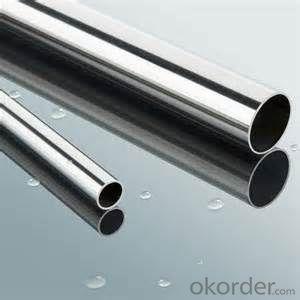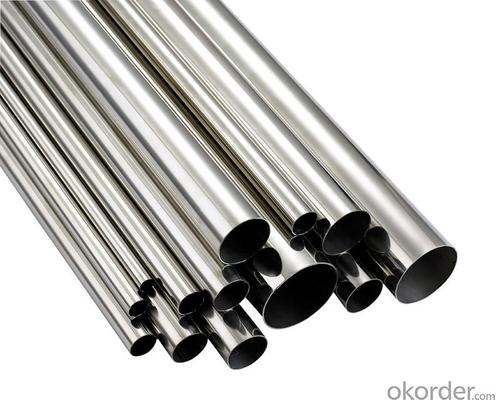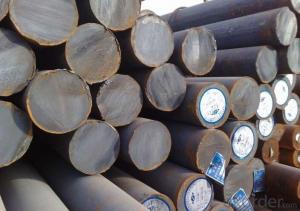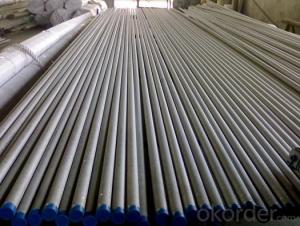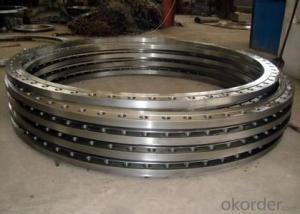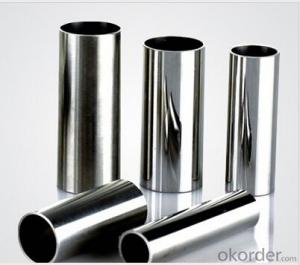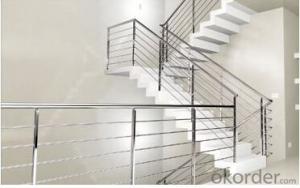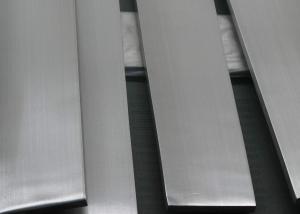STAINLESS STEEL PIPES Material 304 316
- Loading Port:
- China Main Port
- Payment Terms:
- TT OR LC
- Min Order Qty:
- -
- Supply Capability:
- -
OKorder Service Pledge
OKorder Financial Service
You Might Also Like
Description:
Stainless Steel Pipe
Material:
304 321 316 310
Packing:
In bundle
MOQ:
5 TONS
Architecture[edit]
Stainless steel is used for buildings for both practical and aesthetic reasons. Stainless steel was in vogue during the art deco period. The most famous example of this is the upper portion of the Chrysler Building (pictured). Some diners and fast-food restaurants use large ornamental panels and stainless fixtures and furniture. Because of the durability of the material, many of these buildings retain their original appearance.
Type 316 stainless is used on the exterior of both the Petronas Twin Towers and the Jin Mao Building, two of the world's tallest skyscrapers.[17]
The Parliament House of Australia in Canberra has a stainless steel flagpole weighing over 220 tonnes (240 short tons).
The aeration building in the Edmonton Composting Facility, the size of 14 hockey rinks, is the largest stainless steel building in North America.
Bridges[edit]
Cala Galdana Bridge in Minorca (Spain) was the first stainless steel road bridge.
Sant Fruitos Pedestrian Bridge (Catalonia, Spain), arch pedestrian bridge.
Padre Arrupe Bridge (Bilbao, Spain) links the Guggenheim museum to the University of Deusto.[18]
Monuments and sculptures[edit]
The Unisphere, constructed as the theme symbol of the 1964-5 World's Fair in New York City, is constructed of Type 304L stainless steel as a sphere with a diameter of 120 feet, or 36.57 meters.
The Gateway Arch (pictured) is clad entirely in stainless steel: 886 tons (804 metric tonnes) of 0.25 in (6.4 mm) plate, #3 finish, type 304 stainless steel.[19]
The United States Air Force Memorial has an austenitic stainless steel structural skin.
The Atomium in Brussels, Belgium was renovated with stainless-steel cladding in a renovation completed in 2006; previously the spheres and tubes of the structure were clad in aluminium.
The Cloud Gate sculpture by Anish Kapoor, in Chicago US.
The Sibelius monument in Helsinki, Finland, is made entirely of stainless steel tubes.
The Man of Steel (sculpture) under construction in Rotherham, England.
Other[edit]
- Automotive bodies
The Allegheny Ludlum Corporation worked with Ford on various concept cars with stainless steel bodies from the 1930s through the 1970s, as demonstrations of the material's potential. The 1957 and 1958 Cadillac Eldorado Brougham had a stainless steel roof. In 1981 and 1982, the DeLorean DMC-12 production automobile used stainless steel body panels over a glass-reinforced plasticmonocoque. Intercity buses made by Motor Coach Industries are partially made of stainless steel. The aft body panel of the Porsche Cayman model (2-door coupe hatchback) is made of stainless steel. It was discovered during early body prototyping that conventional steel could not be formed without cracking (due to the many curves and angles in that automobile). Thus, Porsche was forced to use stainless steel on the Cayman.
- Passenger rail cars
Rail cars have commonly been manufactured using corrugated stainless steel panels (for additional structural strength). This was particularly popular during the 1960s and 1970s, but has since declined. One notable example was the early Pioneer Zephyr. Notable former manufacturers of stainless steel rolling stock included the Budd Company (USA), which has been licensed to Japan's Tokyu Car Corporation, and the Portuguese company Sorefame. Many railcars in the United States are still manufactured with stainless steel, unlike other countries who have shifted away.
- Aircraft
Budd also built an airplane, the Budd BB-1 Pioneer, of stainless steel tube and sheet, which is on display at the Franklin Institute.
The American Fleetwings Sea Birdamphibious aircraft of 1936 was also built using a spot-welded stainless steel hull.
The Bristol Aeroplane Company built the all-stainless steel Bristol 188 high-speed research aircraft, which first flew in 1963.
The use of stainless steel in mainstream aircraft is hindered by its excessive weight compared to other materials, such as aluminum.
- Jewelry
Valadium, a stainless steel and 12% nickel alloy is used to make class and military rings. Valadium is usually silver-toned, but can be electro-charged to give it a gold tone. The gold tone variety is known as Sun-lite Valadium
- Q: What is the difference between hot rolled and cold drawn stainless steel pipes?
- Hot rolled stainless steel pipes are made by heating a solid steel billet or ingot to a high temperature and then rolling it into the desired shape and size. This process results in a rougher surface finish and a larger grain structure, which can make the pipe more prone to corrosion. However, hot rolled pipes are generally cheaper and easier to produce in large quantities. On the other hand, cold drawn stainless steel pipes are made by pulling a solid steel billet or bar through a die at room temperature. This process results in a smoother surface finish and a smaller grain structure, which improves the pipe's resistance to corrosion. Cold drawn pipes are typically more expensive and require more time and effort to produce, but they offer higher quality and better performance in various applications. In summary, the main difference between hot rolled and cold drawn stainless steel pipes lies in the manufacturing process and the resulting surface finish and grain structure. Hot rolled pipes are cheaper and easier to produce but may be more susceptible to corrosion, while cold drawn pipes are more expensive and time-consuming to manufacture but offer superior corrosion resistance and overall quality.
- Q: Can stainless steel pipes be used for underground drainage systems?
- Yes, stainless steel pipes can be used for underground drainage systems. Stainless steel is a durable and corrosion-resistant material that can withstand the harsh conditions often found underground, such as moisture, soil chemicals, and varying temperatures. It is also resistant to rust, which is a common problem in other types of pipes. Additionally, stainless steel pipes have a long lifespan and require minimal maintenance, making them a suitable choice for underground drainage systems.
- Q: How are stainless steel pipes different from galvanized pipes?
- Stainless steel pipes and galvanized pipes are two distinct types of piping materials, differing in their composition and properties. The primary difference between stainless steel pipes and galvanized pipes lies in their corrosion resistance capabilities. Stainless steel pipes are highly resistant to corrosion due to the presence of chromium, which forms a protective layer on the surface of the pipe. This makes stainless steel pipes ideal for applications where exposure to corrosive substances or harsh environments is expected, such as in the chemical industry or marine applications. On the other hand, galvanized pipes are steel pipes that have been coated with a layer of zinc to prevent rusting. This zinc coating provides some level of protection against corrosion, but it is not as durable or long-lasting as the protective layer formed on stainless steel pipes. Galvanized pipes are commonly used in plumbing and water distribution systems, as well as in outdoor applications where corrosion resistance is still required but not as critical. Another difference between stainless steel pipes and galvanized pipes is their appearance. Stainless steel pipes have a sleek and shiny appearance, often preferred for aesthetic reasons or in applications where appearance matters. Galvanized pipes, on the other hand, have a dull gray color due to the zinc coating. In terms of cost, galvanized pipes are generally more affordable compared to stainless steel pipes. However, the initial cost of stainless steel pipes can be justified by their longevity and superior corrosion resistance, which ultimately leads to lower maintenance and replacement costs over time. It is important to consider the specific requirements of your project or application when choosing between stainless steel pipes and galvanized pipes. Factors such as the environment, expected lifespan, and budgetary constraints should be taken into account to ensure the right choice is made.
- Q: Are stainless steel pipes suitable for wastewater treatment facilities?
- Stainless steel pipes are a great fit for wastewater treatment facilities due to their exceptional corrosion resistance. This quality makes them perfect for managing highly corrosive wastewater. Their ability to resist chemicals and acids prevents deterioration, minimizing the chances of leaks and contamination. Moreover, stainless steel pipes are hygienic and effortless to clean, which is vital in maintaining cleanliness at wastewater treatment facilities. Furthermore, their high strength-to-weight ratio enables easy installation and reduces the necessity for extra support structures. Hence, stainless steel pipes are a dependable and long-lasting option for wastewater treatment facilities.
- Q: Can stainless steel pipes be bent?
- Yes, stainless steel pipes can be bent.
- Q: How do stainless steel pipes compare to HDPE pipes?
- Stainless steel pipes are known for their exceptional durability, corrosion resistance, and high temperature tolerance. They are widely used in various industries, including construction, oil and gas, and food processing. On the other hand, HDPE pipes offer excellent flexibility, lightweight design, and chemical resistance. They are commonly used in plumbing and irrigation systems. In terms of cost, stainless steel pipes are generally more expensive than HDPE pipes. Overall, the choice between stainless steel and HDPE pipes depends on specific application requirements, budget constraints, and desired characteristics such as strength, flexibility, and resistance to corrosion or chemicals.
- Q: What are the limitations of using stainless steel pipes?
- There are several limitations associated with the use of stainless steel pipes. Firstly, stainless steel pipes tend to be more expensive compared to other materials such as PVC or copper. This can make them less feasible for projects with budget constraints. Secondly, stainless steel pipes can be more difficult to install and require specialized tools and equipment. This can increase the overall installation time and cost. Another limitation is that stainless steel pipes are not suitable for transporting certain corrosive chemicals or gases. They may react with certain substances, leading to corrosion and potential damage to the pipes. In such cases, alternative materials like plastic or lined pipes may be more appropriate. Additionally, stainless steel pipes may have limitations in terms of temperature and pressure resistance. While they can handle relatively high temperatures and pressures, extreme conditions may require the use of more robust materials. Furthermore, stainless steel pipes have a lower thermal conductivity compared to other materials, meaning they are not as efficient at transferring heat. This can be a limitation in certain heating or cooling applications where rapid heat transfer is required. Lastly, stainless steel pipes can be prone to expansion and contraction with temperature changes. This may require the use of expansion joints or other measures to accommodate for these movements and prevent potential damage. Overall, while stainless steel pipes offer numerous benefits such as durability and corrosion resistance, their limitations should be carefully considered before selecting them for a particular project.
- Q: What are the common applications for stainless steel pipes?
- Stainless steel pipes have a wide range of applications due to their durability, corrosion resistance, and high strength. Some common applications for stainless steel pipes include plumbing, oil and gas transportation, chemical processing, food and beverage production, pharmaceutical industries, automotive manufacturing, construction, and architecture.
- Q: Why is stainless steel magnetic?
- There are kinds of stainless steel at room temperature, the organizational structure can be divided into several categories: 1. austenitic: such as 304, 321, 316, 310; 2. martensite or ferrite, such as 430, 420, 410; austenitic is non-magnetic or weak magnetic properties, martensite or ferrite is magnetic. Usually used as a decorative stainless steel pipe,Most of the stainless steel plate is Austenitic 304 stainless steel material, is generally non-magnetic or weakly magnetic, but fluctuations in chemical composition caused by smelting or processing of different magnetic properties may also appear, but this can not be considered to be counterfeit or substandard, what is the reason? The above mentioned austenite is non-magnetic or weakly magnetic, and martensite or ferrite is magnetic, due to melting segregation or improper heat treatment, will cause a small amount of martensite Austenitic 304 stainless steel body or ferrite.
- Q: What is the difference between the stainless steel pipe welded pipe and seamless pipe?
- Concentricity: seamless tube manufacturing process is the temperature of 2200 degrees F in stainless steel billet stamping a hole, at this high temperature, tool steel by stamping and drawing become soft and spiral form from the hole. Thus, the wall thickness of the pipeline is uneven and the eccentricity is high. Thus ASTM allows seamless pipe wall thickness ratio of the wall thickness difference of seamed tube. Through the seamed tube cold rolling plate precision (per roll width is 4-5 feet) made. These cold rolled plates usually have a maximum wall thickness of 0.002 inches. The steel plate is cut into a width of PI D, in which D is the outer diameter of the pipe. Tube wall thickness tolerance is very small, and the entire circumference of the wall thickness is very uniform.
Send your message to us
STAINLESS STEEL PIPES Material 304 316
- Loading Port:
- China Main Port
- Payment Terms:
- TT OR LC
- Min Order Qty:
- -
- Supply Capability:
- -
OKorder Service Pledge
OKorder Financial Service
Similar products
Hot products
Hot Searches
Related keywords

